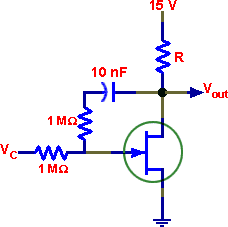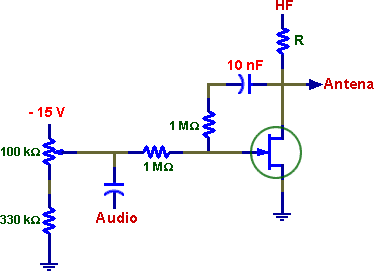Go to EE392 Experiment | 1 | 2 | 3 | 4 | 5 | 6 | 7 | 8 | ECE Lab home
![]()
|
|
Go to EE392 Experiment | 1 | 2 | 3 | 4 | 5 | 6 | 7 | 8 | ECE Lab home |
|
EXPERIMENT I
FIELD EFFECT TRANSISTOR; THE J-FET
OBJECTIVES
Familiarity with basic characteristics and parameters of the J-FET.
Simple FET circuits: J-FET as a current source and a variable resistor.
PRELAB
Draw a circuit for measurements of characteristics of a depletion mode, n-channel JFET, described in part 1 of the Laboratory (below). Sketch basic characteristics of a n-channel J-FET (ID vs. VDS and ID vs. VGS) and explain why it may be used as a constant current source and a voltage controlled resistor. Indicate the parts of the characteristics where these functions can be realized.
References:
P. Horowitz and W. Hill The Art of Electronics, 2nd edition, Cambridge University Press1989, pp.113-129, 138-140.
T. C. Hayes and P. Horowitz and The Student Manual for the Art of Electronics Cambridge University Press 1989, pp. 156-162, for more explanation also pp. 142-147 and 153-155.
LABORATORY
Equipment needed from the stockroom: EE 392 parts kit, analog universal meter, resistance substitution box, leads.
1. JFET CHARACTERISTICS; VP AND IDSS.
Using a curve tracer, compare characteristics (ID vs. VGS) of two n-channel JFET transistors. Are they the same? Note the ranges of values of VDS corresponding to the linear and the saturation regions of the characteristics. You will need this information in part 3.With the source grounded and the drain connected to a 15 V power supply measure drain current ID for different voltages between the gate and the source VGS. Determine Vp (the pinch-off voltage) i.e. the gate voltage at which the drain current is (practically) zero and IDSS (drain current with the gate connected to the source). Vp is best determined from a plot of logID vs. VGS. Measure Vp and IDSS values for the two transistors in your kit. Make sure that you can identify your three transistors according to these values.
2. FET AS A CURRENT SOURCE.
The flat parts of the ID vs. VDS characteristics of the FET allow to use this device as a simple constant current sources because the current is (almost) independent of the voltage across it. Test this idea with two transistors. Measure the current with different values of the load resistor RL chosen from the resistance substitution box.
How good is this current source? Determine the range of the load resistor values which allows the current to stay constant within a given interval (say 2 % or 5%). What is the range of voltage across the transistor operating as a current source.
You can buy JFETs with the gate connected to the source, so called current regulator diodes. These two terminal devices, calibrated for different current values, are current equivalents of Zener diodes which provide a constant voltage.
A variation of JFET current source, with self-biasing, is shown here. One of its advantages is that you can obtain different current values by adjusting the resistor R (a few k). Try this simple circuit and again determine the range of load resistor RL which allows you to keep the current constant.
Is this a better current source than the one without a resistor? How does it work? Do you see feedback in this circuit?
3. JFET AS A VARIABLE RESISTOR.
In the linear part of the JFET ID vs. VDS characteristics, the current through the transistor is (roughly) proportional to the voltage across it, like in a resistor. Moreover, the slope of these characteristics depends on VGS so that changing the latter changes the value of the "resistance". This effect can be used in many "voltage controlled circuits".
Experiment with the JFET as a variable resistor by using it instead of a regular resistor in a two resistor voltage divider. Chose R = 10 k.
Apply a small sinewave signal (about 0.2 V) to the input and observe variation of the output amplitude while changing VGS (negative voltage must be used!). To see if the transistor really behaves as a resistor, switch the waveform generator to a triangular wave. Nonlinear dependence of voltage on current will show as a distortion of the straight lines of the waveform.
In what range of input voltage does the transistor behave approximately as a resistor? Explain your observation.
The circuit shown below is an improved version of as a two resistor voltage divider, with R a regular resistor and the transistor being an adjustable resistor. The divider ratio can be adjusted by the control voltage VC. A compensation circuit (between the output and the transistor gate) greatly improves the circuit linearity as a part of output voltage (what fraction?) is added to VGS. Check that this circuit behaves much better as a voltage controlled resistive divider. Explain.

4. A PROJECT IDEA (OPTIONAL): ONE TRANSISTOR AM TRANSMITTER.
You could use the last circuit for amplitude modulation of a high frequency carrier signal, just as it is done in AM radio transmission. Supply the input with a high frequency sinewave (about 1 MHz) and modulate its amplitude by feeding a low frequency signal (in the kilohertz range) through a capacitor (~ 1 µF) to the slider of the potentiometer. The low frequency signal may be picked up by an AM radio tuned to the appropriate frequency (in this case about 1 MHz). If you supply an amplified signal from a microphone you may hear your voice "on the air". A piece of wire attached to the drain may serve as a transmitter antenna, extending the reception distance.

REPORT
Describe briefly the measurements. Include all schematics. Show all results with proper units. Do not forget to include frequency for ac measurements. Show the values of IDSS and VP on the graphs of ID vs. VGS characteristics for the two transistors. You may even prepare one graph with three curves identifying them by color or line style (thick, thin, dashed, etc.) In the discussion comment whether the parameters IDSS and VP well describe a given transistor type. Address the topics and answer the questions in bold letters in the manual. Add any observations or conclusions you wish to make.
|
|
Go to EE392 Experiment | 1 | 2 | 3 | 4 | 5 | 6 | 7 | 8 | ECE Lab home |
|